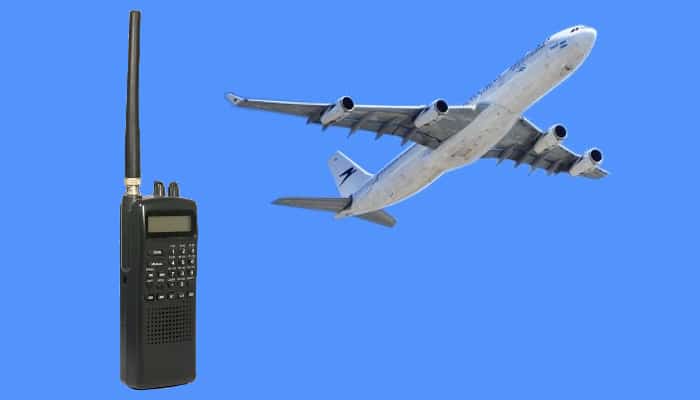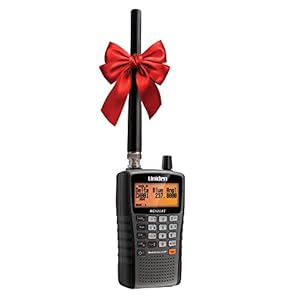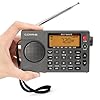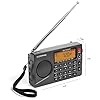(When you buy through links on our site, we may earn an affiliate commission.)
In this article, I review 5 of the best aviation handheld radios:
- Uniden Bearcat BC125AT handheld scanner
- C Crane Skywave airband radio with scanner and SSB
- Uniden Bearcat SR30C
- Whistler WS1010 analog handheld scanner
If you don’t have time to read the whole article, here is my recommendation:
If you want to listen to aviation communications (both civil and military) with a scanner, then I recommend the Uniden Bearcat BC125AT handheld scanner Its scanner functions will make listening to pilots and ATC a breeze.
What is airband radio and what are the frequencies?
Airband is the name given to the range of frequencies that are allocated for use by pilots and air traffic controllers from civil aviation (non-military).
The VHF airband uses the frequencies between 108 and 137 MHz. The lower part of this range (from 108–117.95 MHz) is reserved for navigational aids such as VOR beacons and ILS.
The remaining upper part of this range (118–136.975 MHz) is where the pilots and ATC communicate. You need a special airband radio to listen to this frequency range. If you take a look at a “normal” radio, you will see the FM band frequency range is 88 to 108 MHz, ie it stops just below airband. That is why you need one of the airband radios / scanners / receivers mentioned below in this article.
What about military aviation radio communication?
Military aircraft use a dedicated UHF-AM band from 225.0–399.95 MHz for air-to-air and air-to-ground, including air traffic control communication. So if you want to listen to military aircraft and air traffic control, you will need a receiver (radio or scanner) with that range of frequencies.
How do I listen to pilots and air traffic control (ATC) on airband?
You will need a special airband radio or radio scanner that has the frequencies you are interested in (see above).
What is a radio scanner and do I need one?
A radio scanner will scan a group of frequencies that you have specified, looking for activity. As soon as there is “activity” (ie someone starts talking), it will immediately go to that frequency and stop there so that you can listen to what is being said.
To understand why this is useful when listening to aviation communications, imagine you are New York JFK airport and you want to listen to the various radio communications that are going on. There are about 10 different frequencies for different uses at JFK. Example – 121.900 MHz is for ground movements and 123.900 is the frequency for the tower for runways 4L/22R and 13R/31L. If you wanted to monitor these 2 frequencies with an airband radio (not a scanner), you’d have to keep switching back and forth manually between those 2 frequencies until there is some activity. That might not sound like a big deal, but it can quickly get annoying. Often communications are quite short, so you’ll be missing a lot of them.
With a scanner, you could program the scanner to automatically monitor those 2 channels for you, then as soon as there is activity, the scanner will immediately change to that channel for you automatically.
Do I need an analog scanner or digital scanner?
An analog scanner will pick up transmissions done in analog only. A digital scanner will pick up transmissions done in analog and digital.
Airband communications are analog. They are not digital. Therefore, if you are thinking of buying a scanner to listen to airband, you only need an analog scanner. You do NOT need a more expensive digital scanner. All of the scanners I reviewed for this article (see below) are analog because that is all you need to listen to pilots and ATC.
A digital scanner is only needed to listen to digital communications. So what is transmitted digitally? Well things like the emergency services (police, fire, ambulance) in some locations (but not everywhere) are now being transmitted digitally.
Conclusion: If you’re only interested in listening to aviation radio communications, an analog receiver or scanner is fine.
What to look for in an airband radio / scanner
Power sources
All airband radios and scanners are battery operated because they are mainly used when out and about. Some of them can also be powered with an AC power cord plugged into a power outlet / socket. That would be useful if you live close to an airport.
Battery life
Be sure to check the battery life. The scanners often have a shorter battery life than the airband radios.
Size and weight
Since, you’ll be carrying the radio or scanner around, it’s important that it reasonably compact and light, without compromising audio quality or ease of use.
Memory presets
A memory preset is the ability to save to memory a specific frequency (channel). For example, if you wanted to save 10 frequencies at JFK, you’d need 10 memory presets.
Civil aviation / military aviation
Make sure the radio or scanner has the frequencies for the type of aviation you want to listen to (civil and/or military).
Civil: 118 – 137 MHz
Military: 225.0 – 399.95 MHz
The best airband radios
Uniden Bearcat BC125AT handheld scanner
The Uniden Bearcat BC125AT is an analog scanner.
Listen to Over 40,000 Frequencies
The Bearcat BC125AT handheld scanner gives you direct access to over 40,000 frequencies. You can listen to both civilian and military aviation bands. You can also listen to analog transmissions by police, ambulance, fire, weather, marine, aircraft, railroad, civil air, amateur radio services, and racing.
Frequencies
25-54 MHz
108-174 MHz (includes civil aviation)
225-380 MHz (includes military aviation)
400-512 MHz
500 Alpha-Tagged Channels
Finding the channel you want to listen to is easy, with 500 channels divided into 10 storage banks. It’s possible to organize your channels by department, location, area of interest, or any other way you prefer. Alpha Tagging lets you assign names to your channels, so you can keep track of who you are listening to.
Lightweight, Portable Design
Take this Bearcat handheld radio scanner with you on the road, or on outings. It packs plenty of features in a lightweight, portable design.
Technical specifications
Audio power: 0.36W
Power sources: USB cable is included to power the unit or to recharge the batteries. 2x rechargeable AA batteries (included).
Dimensions (without antenna): 4.5 x 2.6 x 1.3 inches (115 x 67 x 33.3 mm)
Weight (without antenna and batteries): 6.24 ounces (177 grams)
In the box
- BC125AT scanner with attached belt clip.
- Antenna
- 2x rechargeable Ni-MH Batteries (size AA)
- USB cable
- Wrist strap
Pros
- Good sound. The filtering in this scanner is able to filter out static noise and interference.
- Compact size and lightweight. Easy to carry.
- Alpha Numeric channel programming and labeling. The ability to add labels to each channel as it appears on the screen during a transmission makes it easier to know what is actually happening. Example you can label one as “JFK ground” and another as “JFK Tower”.
- The free Windows software available from the Uniden website (link in the user manual) is very useful for entering the frequencies you wanted along with a name for each channel, save it to a file on your PC, then upload the file to the scanner.
- The multi-function “volume knob.” The rotary knob has many functions including setting the volume, adjusting the squelch, scrolling through the channels saved in banks.
- Adjustable screen brightness and contrast. Makes it very easy to read information on the screen in all lighting conditions.
Cons
- Recharging – It charges through the USB cable, and only charges the batteries when the unit is turned off. If the BC125AT is on, the batteries will not receive a charge.
- The user manual could be better. All the information is there but it could be better written.
C Crane Skywave airband radio with scanner and SSB
The “C Crane Skywave airband radio with scanner and SSB” is a very advanced radio. It does much more than receive airband radio.
3 very advanced features
There are 3 advanced features which justify the higher price:
- There is an airband radio scanner. In other words, you can specify 10 channels of your choice within the airband frequency range (118 – 137 MHz) and then the device will scan them continuously and automatically for activity. This essentially transforms the device into an airband scanner.
- The ability to listen to frequencies on SSB (Single-Side Band) – Single Side Band is an efficient and reliable way to get long range communications. You can now listen to FEMA, long range aviation, ships at sea, space even spy transmissions and other worldwide communication.
- This model also has the FULL shortwave band (1711 – 29999 kHz) and comes with a shortwave reel antenna.
Frequencies
FM: 87.5 – 108 MHz
Airband: 118 – 137 MHz
AM: 520 – 1710 kHz
Weather: All 7 NOAA channels for the NOAA alerts
SW: 1711 – 29999 kHz (full SW band)
Technical specifications
Power output: 0.5W
Battery life: 60-70 hrs at moderate volume.
Power sources: AC adaptor (not included) or 2x AA batteries (not included).
Dimensions: 4.75 x 3 x 1.1 inches (120.65 x 76.2 x 28 mm)
Weight (without batteries): 5.5 ounces (156 grams)
In the box
- C Crane Skywave airband radio scanner with SSB.
- Shortwave reel antenna.
- Earbuds.
- Carry case.
Pros
- Airband scanner.
- Single Side Band (SSB) – For long range communications.
- FULL shortwave band (1711 – 29999 kHz).
- Long battery life.
- Small size and very light.
- NOAA weather alerts.
- 400 memory presets.
- Clock function.
- Squelch feature filters out background noise – No more annoying interference in between airband transmissions.
Cons
- AC adaptor is not included with the radio.
- The audio quality is a bit tinny due to the speaker’s small size.
Uniden Bearcat SR30C
The Uniden Bearcat SR30C is an excellent affordable analog scanner. It covers the full range of civil aviation airband frequencies.
As well as civil aviation airband, the Uniden Bearcat SR30C scanner covers the bands used by emergency services (fire, police, ambulance) as well as marine, racing, HAM radio, railroad / trains, CB radio and weather.
With this scanner, you will have access to the NOAA emergency weather alerts in the USA.
500 programmed channels
You can program up to 500 channels into the scanner’s memory. Then, you can scan for transmissions on the stored channels.
Close Call RF Capture Technology
Close Call automatically detects and tunes to nearby transmissions that are local, even if the frequency isn’t programmed into a channel.
Ten Preprogrammed Service Search Bands
Easily search for frequencies typically used by Police, Fire/Emergency, Marine, Racing, Civil Air, Ham Radio, Railroad, CB Radio, Weather, and more.
Powering the Uniden Bearcat SR30C
Use the provided USB cable to connect your scanner to your computer to charge the Ni-MH batteries (not included) on initial installation and to recharge them. You can also use a power adapter that provides USB charge power (not included, but available at many retailers). You can also use alkaline (ALK) non-rechargeable batteries (not included).
PC Programming
You can connect your scanner to your PC through the USB cable in order to program channels into the scanner and to change any of the settings. The USB drivers and programming software are available for free download from Uniden’s website.
Frequencies
25-54 MHz
108-174 MHz (includes civil aviation)
406 – 512 MHz
Technical specifications
Audio power: 0.36W
Power sources: USB cable is included to power the unit or to recharge the batteries if you are using rechargeable batteries. 2x AA batteries (not included).
Dimensions (without antenna): 4.5 x 2.6 x 1.28 inches (115 x 67 x 32.7 mm)
Weight (without antenna and batteries): 6.17 ounces (175 grams)
In the box
- Uniden Bearcat SR30C scanner
- Antenna
- Belt clip (attached to scanner)
- USB cable
- Strap
- User manual
Pros
- Close Call RF Capture Technology: Close Call automatically detects and tunes to nearby transmissions, even if the frequency isn’t programmed into a channel.
- Good sound. The filtering in this scanner is able to filter out static noise and interference.
- Compact size and lightweight. Easy to carry.
- PC programming – Easily program the channels you want to listen to via the free software for PC.
Cons
- Batteries not included.
Whistler WS1010 analog handheld scanner
The Whistler WS1010 is an analog scanner. You will be able to listen to civil aviation (airband) with this scanner as well as many other bands (see below).
Lock-out Function – Skip over specified channels or frequencies that you’re not interested in when scanning or searching.
Tune – Find new and unlisted frequencies starting from a specified frequency.
200 Channel memory -The 200 channel memory gives you plenty of memory to store all your favorite frequencies in 10 separate storage banks.
Scan Delay – Delays scanning for two seconds before moving to another channel in order to hear replies.
Priority Channel – Set the scanner to check one channel every two seconds while scanning.
PC programmable – You can backup data, update database and program the scanner directly from a PC with the free software.
One touch search – One-touch searches of marine, fire/police, air, ham and weather frequencies.
Other features
- Backlit Liquid Crystal Display (LCD)
- Data cloning
- Flexible antenna with BNC connector
- Memory backup
- Priority channel
- SAME and All Hazards Weather Alerting
- Service banks
Frequencies
29 – 54 MHz (10 meter HAM, VHF Lo, 6 Meter Ham)
108 – 136.9875 MHz (Civil aviation)
137 – 174 MHz (Military land mobile, 2 meter Ham, VHF Hi)
380 – 512 MHz (UHF aircraft, Federal government, 70cm Ham, UHF standard, UHF “T”)
Technical specifications
Audio Output Power (10% THD): 180mW Nominal
Power sources: 9V AC Adapter (included) / 4 AA Batteries (not included)
Dimensions : 5.68 x 2.37 x 1.56 inches (145 x 63 x 40 mm)
Weight (without antenna): 7.8 oz (220 g)
In the box
- Whistler WS1010 hand-held scanner
- AC adapter
- Flex antenna
- Black battery shell
- Yellow rechargeable battery shell
- User guide and quick start guide
Pros
- Comes pre-programmed out of the box.
- Easy to program and configure, if necessary.
- Compact and lightweight.
- User guide easy to understand and good after-sales support from manufacturer.
Cons
- Doesn’t have military aviation bands.
- Can’t turn off the backlight.
Conclusion
So what is the best aviation handheld radio?
If you want to listen to aviation communications (both civil and military) with a scanner, then I recommend the Uniden Bearcat BC125AT handheld scanner. Its scanner functions will make listening to pilots and ATC a breeze.
























Great, I am looking for a aviation handheld radio. I like your post, the way you write. Your post is so detailed and easy for people to understand.
I bought skywave radio immediately after reading your article. Having said that, this radio exceeded all the positive reviews and the few negative
ones were more of a particular persons own lack of knowledge or willingness to “work around” certain inherent issues. It’s great
Great short reviews. Radio is very interesting and you’re making it more so
I used the free Windows software from Uniden’s website to gather the channels and save the information on my PC. Afterwhich, I uploaded them on my scanner, ready to be used anytime. The storage method is convenient and effortless.